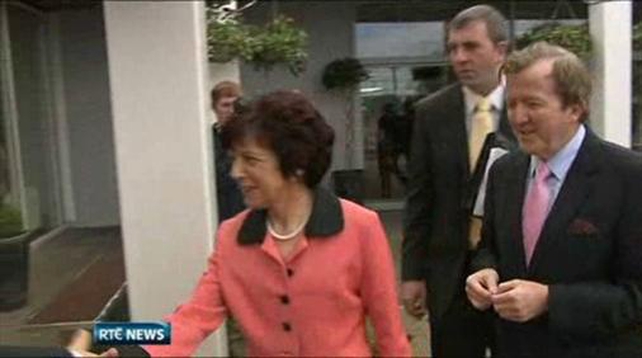FG minister of state John Perry and his wife consent to a €2.47m court judgment


MARIE AND JOHN PERRY HAD SOUGHT A THREE-MONTH STAY TO ALLOW FOR RESTRUCTURING PROPOSALS TO BE PUT TO THE BANK
Fine Gael Minister of State John Perry and his wife have consented to judgment for €2.47m being entered against them at the Commercial Court over unpaid loans.
Counsel for Mr Perry and his wife Marie told Mr Justice Peter Kelly today that they contradict several claims in affidavits of Danske Bank.
However, they accepted they had no bona fide defence to judgment and were consenting to judgment in the amount of €2,474,346.
The judge entered judgment in that amount and also granted the couple a stay on execution and registration of the judgment until 2 September.
Counsel for the couple had sought a three-month stay to allow for restructuring proposals to be advanced by them to the bank.
Rossa Fanning, for the bank, opposed a stay of that duration saying there had been ample time for proposals to be advanced.
The judge said he would not grant the three months but would grant a stay to 2 September.
Given the couple’s attitude to the bank’s application, he added he would only award costs at the lowest level against them.
The bank sued the couple, of Carrownanty, Ballymote, Co Sligo, arising from an October 2011 facility for €2.42m provided to restructure existing loans.
It claimed the security for the facility included first legal mortgages over a retail premises, the Stone Park Restaurant and Perry’s Hardware, all located at Main Street, Ballymote, and over 50 acres of agricultural lands at Ballymote.
It claimed the loan was to be repaid in full 12 months after it was drawn down in November 2011, with the effect that the final repayment date was 12 November 2012.
The couple made some repayments but, the bank claims, failed to keep up the level of interim repayments required under the terms of the loan facility.
Last March, it demanded immediate payment of the total sum outstanding, with interest, of about €2.47m.
State agency to report on proposed merger of Bord na Móna and Coillte
 +
+
Cold spell helps Bord na Móna return to profit
The commercial semi-State sector, will issue a report to government before “year end” on the proposed merger of Bord na Móna and Coillte.
Gabriel D’Arcy, the chief executive of Bord Na Móna, said the company had been asked by New Era to contribute to the report, whichhe said should be ready “by the back end of the year”.
He said he had “not yet formed a view” as to whether a merger was a good idea, but that there is “merit” in the state exploring the idea. “We will co-operate fully,” he said.
Bord na Móna yesterday reported a 11 per cent increase in turnover to a record €426.1 million for the financial year ended March 2013.
Figures published by the company show a return to profit and an increase in cash flow for the group, which said the results highlight the importance of a balanced business portfolio that includes power generation, resource recovery and retail products.
Operating profits after exceptional items increased to €23.5 million, up from a loss of €3.7 million in 2012, while operating cash flow increased from €42.3 million to €108.5 million during the year.
Overall profits
Overall profits, after exceptional items, for the group were €9.2 million compared to a loss of €16 million in 2012.
The company said the increase in turnover was reflective of the prolonged cold winter weather and the positive impact this had on fuel sales.
Earnings before interest, tax, depreciation and amortisation for the period were €61.2 million.
D’Arcy said the results owe a great deal to the diverse strengths of the company and the implementation of cost-reduction measures.
The group’s chairman, John Horgan, said Bord na Móna would be advancing some big projects in the coming year as part of an investment programme in wind and renewable energy sources.
“We will also continue to engage with other stakeholders in relation to the provision of a sustainable water source for the eastern region.
“These significant infrastructural projects, combined with our drive for effective operations across the group, are part of our ongoing sustainable business strategy.”
During the year the group expanded its wind energy portfolio at Oweninny, Co Mayo, as well as at Mount Lucas and Bruckana in the midlands.
During the accounting period exceptional items which affected the company’s profitability included a €23 million impairment charge in relation to the the group’s waste management business.
Exceptional costs of €23.5 million were also incurred as a result of the poor harvest in 2012, which was the lowest in the company’s history, representing just 37 per cent of the harvest target.
The lack of qualified personnel among Irish child-carers sparks anger & concern
The Minister for children Francis Fitzgerald plans to make it obligatory for people working in area to be qualified
Concern has been expressed following the publication of data showing most people caring for young children have no childcare qualifications.
A report by the Economic and Social Research Institute shows most nine-month-olds in childcare are looked after by relatives (42 per cent) or child-minders (31 per cent) in the home. But 55 per cent of child-minders and more than 83 per cent of relatives who look after children have no qualifications in the area.
“That is of concern,” said Frances McGinnity, co-author of the report, part of the Growing Up in Ireland project. The study involved interviews with the parents of more than 11,000 nine-month-old babies. The children will be tracked again at three years of age.
Ms McGinnity said there was a link between the qualifications of people who cared for children and the quality of care. In creches and preschool centres just 1.9 per cent of employees are not qualified. More than 67 per cent had Fetac awards, more than 20 per cent had third-level qualifications in the area, almost 4 per cent had qualifications from abroad and more than 6 per cent had done related courses.
Benchmark qualifications
Minister for Children Frances Fitzgerald said she planned to make it obligatory for all childcare workers to have qualifications. She added: “Clearly this report points to the critical importance of building childcare supports for families so that they have greater choice.”
Minister for Children Frances Fitzgerald said she planned to make it obligatory for all childcare workers to have qualifications. She added: “Clearly this report points to the critical importance of building childcare supports for families so that they have greater choice.”
Cost was often a factor for parents: only a third of relatives who cared for children in the family home were paid. The most expensive childcare was a child-minder in the family home at an average of €7.35 per hour, though this could involve several children. The average hourly rate in a creche or preschool centre was €5.71.
Nine-month-olds who attended creche-type centres were more likely to develop infections. Almost half of infants attending creches had picked up chest infections, compared with about 30 per cent cared for at home. Nine-month-olds in creches were almost twice as likely to get an ear infection or have severe vomiting.
Creches and other centre-based care were more likely to say nine-month-olds spent no time watching television, at 83 per cent, as opposed to home-based carers, 53.2 per cent of whom said the infants watched no television. Babies in home settings were more likely to have individual interactions with the carer but less access to learning-enhancing activities and books.
Ninety-four per cent of mothers said they were satisfied with their childcare when it was by a relative, 88 per cent were satisfied with care involving a child-minder and 73 per cent when the care involved a creche.
The report shows paid maternity leave influences women’s employment patterns after having children, with few returning to work within six months. Women with higher incomes and education were more likely to take unpaid leave. The report notes 12 per cent of men had taken unpaid leave by the time their child was nine months.
Ms Fitzgerald said Ireland had “a long way to go” on access and affordability to care. The system reflected the “policy choices” where payments to parents were preferred over investing in childcare.
Big fears over medicine shortages in Ireland
MEDICINE SHORTAGES ARE POSING A RISK TO THE HEALTH OF PATIENTS IN IRELAND, ACCORDING TO THE IRISH PHARMACY UNION (IPU).
Shortages of certain antidepressants, pain-relief medicines and eye ointments have been highlighted by the group, which has called on the Department of Health to intervene.
An IPU survey of 200 pharmacists revealed that nearly 50pc believe that patients’ health has been adversely affected by medicine shortages.
Why has global warming slowed down?


Solar energy is absorbed by the oceans
With Britain’s and Ireland’s heatwave reaching a peak, there could be no better moment to talk about why global warming has slowed to a standstill.
It reminds me of reporting on a drought a few years ago: while filming interviews with people about the impact, the heavens opened and rainwater was soon flowing down my neck.
So as journalists were invited to the Science Media Centre in London to hear how the worldwide rise in temperatures has stalled, the mercury shot up as if on cue to record the hottest day of the year so far.
In many ways, this event was long overdue: climate sceptics have for years pointed out that the world is not warming as rapidly as once forecast.
A lot depends on how you do the measurements, of course.explanations but none of them adds up to a definitive smoking gun.”
Each of the last few decades has been warmer than the last. But start your graph in 1998 – which happened to be an exceptionally warm year – and there hasn’t been much global warming at all.
Gradually the words ‘pause’ and ‘hiatus’ which first featured in the blogs have crossed to the media and then to the scientists professionally engaged in researching the global climate.
The headline – which the scientists will not thank me for – is that no one is really sure why the rate of warming has stumbled.
Industrialisation may lead to a drop in global temperatures in the 1940s
Professor Piers Forster of Leeds University has tried to quantify the different factors involved – what’s known as their “radiative forcing”.
Between 1998-2012, he reckons, manmade greenhouse gases were still the biggest influence, causing warming of 0.48 of a Watt per square metre (a key measure of energy flows to and from the planet).
At the same, he estimates, two other natural influences might have led to some cooling: a relatively quiet Sun might have been responsible for a reduction of 0.16 of a Watt/sq m and volcanic eruptions another 0.06 Watt/sq m.
A big unknown is the effect of aerosols – tiny particles released by industrial pollution which could cause a further cooling effect.
It is thought that the world’s massive industrialisation after World War Two contributed to a slight drop in global temperatures in the late 1940s.
But the key factor – according to all the speakers at the briefing – is that whatever solar energy is making it through to the surface, much is being absorbed by the hidden depths of the oceans.
The Argo network of automated monitors has been deployed since 2005 to measure the waters as deep as 1,800m. This isn’t a very long period but the data are apparently showing some warming – even in this short time frame.
And readings from satellites since 2000 show how much energy is arriving at the planet, and how much is leaving, so if the energy left behind is not manifesting itself in rising surface temperatures, then it must be going somewhere – and the deep ocean is the most plausible explanation.
Pauses expected: On top of that, the scientists say, pauses in warming were always to be expected. This is new – at least to me.
It is common sense that climate change would not happen in a neat, linear away but instead in fits and starts.
But I’ve never heard leading researchers mention the possibility before.
Professor Rowan Sutton, of Reading University, said computer simulations or models of possible future climate scenarios often show periods of ten years with no warming trend – some even show pauses of 20-25 years.
And Professor Stephen Belcher, head of the Met Office Hadley Centre, said observations and models showed that on average there were – or would be – two pauses in warming every century.
I asked why this had not come up in earlier presentations. No one really had an answer, except to say that this “message” about pauses had not been communicated widely.
So where does this leave us, as greenhouse gases emissions keep rising but the temperature does not?
Dr Peter Stott, of the Met Office, pointed out that 12 of the 14 warmest years have occurred since the year 2000 and says that other indicators – like the decline in Arctic sea ice of 12.9% per decade and losses of snow cover and glaciers – still point to a process of manmade warming.
Bad maths: But what about another possibility – that the calculations are wrong?
What if the climate models – which are the very basis for all discussions of what to do about global warming – exaggerate the sensitivity of the climate to rising carbon dioxide?
Dr Stott conceded that the projections showing the most rapid warming now look less likely, given recent observations, but that others remain largely unchanged.
A Met Office briefing document, released at the briefing, says that, even allowing for the temperatures of the last decade, the most likely warming scenario is only reduced by 10% – so “the warming that we might have expected by 2050 would be delayed by only a few years”.
Overall, it concludes, the pause “does not materially alter the risks of substantial warming of the Earth by the end of this century.”
In other words, global warming is still on.
But until the pause can be properly explained, many people will take a lot of convincing – especially if the pause lasts longer than expected.
Cassini spacecraft photographs Earth from 900 million miles away


If you waved at Saturn last Friday, some of the photons that bounced off your arm could be in this image.
Seen from about 1.4 billion kilometres away, Earth is the bright white dot hovering below Saturn’s famous rings. The snap comes from NASA’s Cassini spacecraft, which on 19 July was taking pictures of the giant planet backlit by the sun. Cassini’s goal is to stitch together a portrait of the entire planet in this lighting, which allows the team to see details in the fainter, more diffuse rings. The full mosaic won’t be ready for another six weeks, but Argentinian astronomy blogger Guillermo Abramson has already colourised this raw Cassini picture – posted over the weekend on a NASA website – of Earth photobombing Saturn.
People all over the planet were looking up at Saturn at 9.27 pm GMT on 19 July, as Cassini was taking a photo of the rings with Earth in the frame. Cassini’s telescopic camera also zoomed in for a closer look at Earth and caught a glimpse of the moon as well.
Of course, the odds that the spacecraft caught a photon bouncing off a waving arm are about one in a million, according to back-of-the-envelope calculations by Sky & Telescope magazine. But the event probably marks the first time people on Earth have been smiling for the camera when a spacecraft took our picture.




No comments:
Post a Comment